
☊ Among all the natural wonders that our world has to offer, one that never fails to capture my imagination is the return of the sun above the Arctic Circle around this time of year. Just a couple weeks ago–January 23 to be exact–the sun peaked from behind the horizon for about an hour, the fist time it had done so since November 18. For the inhabitants of that frigid region on our globe, that’s 66 days without a sunrise.
If you recall your eighth grade Earth science lessons, this phenomenon occurs both in the Arctic and Antarctic due to the tilt of the Earth’s axis. During a northern winter, the Earth is tilted away from the sun, resulting in a period of “polar night” above the Arctic Circle. During the northern summer the Earth is tilted in the other direction and the same region basks in “midnight sun,” with no sunset for two months.
A couple years ago, my dad, an adventurous educator, took my sons and me up to Alaska to witness the return of the sun. We traveled for nearly twenty-four hours to Utqiagvik, the northern most town in the United States. It was a homecoming of sorts for me, having spent two years of my childhood there the first time my parents decided to be adventurous. It was now time for my kids to share the experience.
As you might imagine, Utqiagvik is a quiet place in the winter. Temperatures hover around -30 degrees Fahrenheit, the Arctic Ocean is frozen solid, and there is not a tree or hill in sight. The tundra landscape is white and flat as far as the eye can see, save for the scattered snow drifts that resemble desert sand dunes. Building architecture is simple and utilitarian, designed for thermal efficiency rather than aesthetics. People tend to stay indoors, for obvious reasons.
The pace and mood of the community changes somewhat during this time. While there is an acknowledgement and acceptance of the quiet Arctic darkness, there is also a keen anticipation of the sun’s return. The residents of Utqiagvik live full lives working and attending school during the two months of night, but they do so as if they’re working towards something, sewing seeds in the dark that won’t blossom until dawn. Rather than a period that one must simply endure, night has purpose.
With the “polar night” on my mind as I considered today’s Gospel passage from Mark, I picked up on a detail I hadn’t noticed before. After Jesus heals Simon’s mother-in-law, Mark tells us that “…at sunset, people brought to Jesus those who were sick or demon-posessed. The whole town gathered near the door.” And then, “…well before sunrise, Jesus rose and went to a deserted place where he could be alone in prayer.” Did you catch it? The action of this passage takes place in darkness, between sunset and sunrise. Jesus heals, presumably up all night, tending to the needs of the whole town. Then, with a full, but likely weary heart, Jesus pulls himself away to pray alone and await the dawn’s light.
This is the first time that Jesus engages a large crowd and reveals his power as a healer. He had recently taught in the temple, where he cast out one demon, but this long, dark night at Simon’s house was entirely different. A new dimension of Jesus’ power and authority was born, and by dawn, after resting with God, he was ready to show it to the world–and he does. The next several passages in Mark tell the story of Jesus’ full public emergence as a preacher, teacher, and healer.
Just as the polar night is a quiet, but intentional and productive time for the people of Utqiagvik, Alaska, Jesus’ nighttime healings poised and prepared him to live fully into his call upon the sun’s rising.
The season of Epiphany, which the Church is currently observing, finds much of its meaning in the metaphorical interplay between darkness and light. As the Eucharistic proper preface for Epiphany states, “…you have caused a new light to shine in our hearts, to give the knowledge of your glory in the face of your Son Jesus Christ our Lord.” We recognize the return of the sun this season and all of the fullness of life it brings, but we also acknowledge the importance of winter’s darkness as a season of holy preparation, a period of purposeful pause before the dawn.
I wonder how this metaphor speaks to you. Perhaps you have experienced a season of winter, a “polar night” in your life. Perhaps you are experiencing one right now. The seeds that have been planted in you by God are gathering energy during this time of dormancy, every day growing closer and closer to the moment when they can burst from the ground and greet the sun, allowing you to live ever more fully into your call as God’s own. In his poem, “The Winter of Listening,” David Whyte captures this sentiment well: “Inside everyone / is a great shout of joy / waiting to be born. / Even with summer / so far off / I feel it grown in me / now and ready / to arrive in the world.”
I know I’ll never forget sitting out on the frozen tundra watching the sun rise that day with my kids. And I pray that the trip planted a few seeds in them to someday embark on adventures of their own and seek out other sunrises in their lives. Just as the sun rises anew this season, may it also rise anew in your hearts. Inside everyone is a great shout of joy waiting to be born.
Epiphany 5, Year B